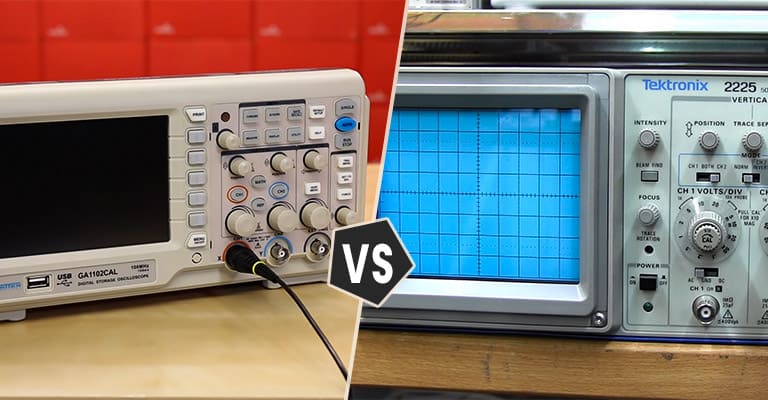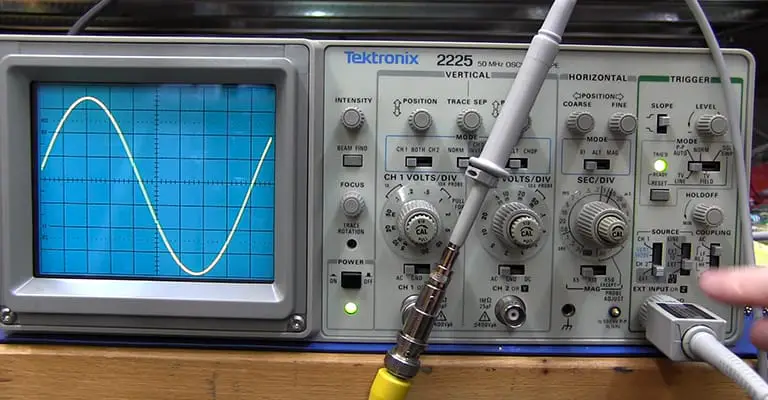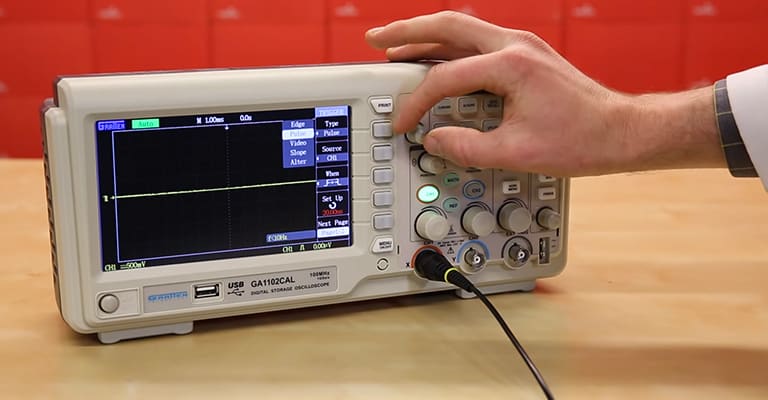You might have seen many wizards or magicians with their wands in movies, right? These wands made them extremely powerful and almost could do everything. Huh, if these were true. But you know, almost every researcher and lab comes with a magic wand too. Yeah, this is an oscilloscope that paved the way for magic inventions. 
In 1893, scientists invented a massive gizmo, the oscilloscope. The main role of the machine was that it could take the reading of electrical signals. This machine could also plot the properties of the signal in a graph. These capabilities torrented the development of the electrical and communication sectors vastly.
In this era, oscilloscopes have displays and they show a pulse or signal very sharply. But due to technology oscilloscopes became classified into two types. Digital oscilloscope and analog oscilloscope. Our explanation will give you a lucid idea of which one you need.
In this post we'll cover:
What is The Analog oscilloscope?
Analog oscilloscopes are simply the older versions of the digital oscilloscopes. These gadgets come with slightly lesser features and maneuverability. For instance, these oscilloscopes come with older cathode ray tube display, limited frequency bandwidth, etc.

History
When French physicist André Blondel first invented an oscilloscope, it used to plot electrical signals mechanically on a graph. As it had many restrictions, in 1897 Karl Ferdinand Braun added a cathode ray tube to see the signal on display. After a handful of development, we found our first analog oscilloscope in 1940.
Features and Technology
Analog oscilloscopes are the simplest among those currently available in the market. Previously, these oscilloscopes were happened to offer a CRT or cathode ray tube to show the signal but currently, you can find an LCD displayed one easily. Generally, these have fewer channels and bandwidth, but these are enough for simple workshops.
Usability in Modern Times
Though an analog oscilloscope may sound like backdated, this is enough for you if your works are within the capability of the oscilloscope. These oscilloscopes may not have more channel options like a digital one but for a beginner, this is more than enough. So, you need to know your requirements first regardless of the type.
What is a Digital Oscilloscope?
After a substantial amount of effort and development program, the digital oscilloscope came. Though the basic work principle of both of these is the same, the digital comes with an extra capability of manipulation. It can save the wave with some digital numbers and show it on the display decoding it.

History
Starting from the first oscilloscope, scientists kept researching to develop it more and more. After a couple of developments, the first digital oscilloscope came into the market in the year of 1985. These oscilloscopes had surprisingly wide bandwidth, low power consumption, and some other great extra features too.
Features and Technology
Though these are the top-notch products of the market, there are also some variations among digital oscilloscopes according to their technology. These are:
- Digital Storage Oscilloscopes (DSO)
- Digital Stroboscopic Oscilloscopes (DSaO)
- Digital Phosphor Oscilloscopes (DPO)
DSO
The Digital Storage Oscilloscopes are simply designed and widely used digital oscilloscopes. Mainly, raster-type displays are used in these oscilloscopes. The only drawback of this type of oscilloscopes is that these oscilloscopes can’t figure out the real-time intensity.
DSaO
The inclusion of a sampling bridge before the attenuator or amplifier circuit makes it quite distinct. The sampling bridge samples the signal before the amplification process. As the sampled signal is of low frequency, a low bandwidth amplifier is used which makes the output wave smooth and accurate.
DPO
Digital Phosphor Oscilloscope is the oldest type of digital oscilloscope. These oscilloscopes are not widely used nowadays but these oscilloscopes are of totally different architecture. So, these oscilloscopes could offer different capabilities while reconstructing the signal on the display.
Usability in Modern Times
Digital oscilloscopes are the top-notch oscilloscope currently available in the market. So, there is no doubt about their usability in modern times. But one thing you should keep in mind that, you will have to select the best fitting one. Because the technology of oscilloscopes varies according to their purposes.
Analog Oscilloscope Vs Digital Oscilloscope
Undoubtedly, a digital oscilloscope gets the upper hand over an analog, comparing some differences. But these differences may stand useless for you because of your work requirement. To solve this problem, we are giving a short comparison to let you acknowledge the key differences.
Most of the digital oscilloscopes include sharp and powerful display LCD or LED displays. Whereas, most of the analog oscilloscopes come with CRT displays. Digital oscilloscopes come with a memory that saves the digital numeric value of the signal and also can process it.
The implementation of the ADC or analog to digital converter circuit makes a substantial gap between an analog and digital oscilloscope. Except for these facilities, you may have more channels for different signals and some extra functions which are not found in a general analog oscilloscope.
Final Recommendation
Basically, the working principle of both analog and digital oscilloscopes are the same. A digital oscilloscope includes a few more extra technologies for better signal processing and manipulation with more channels. On the contrary, the analog oscilloscope may include a little bit of older display and features. You may think they are more like a multimeter with a graph, but there are some basic differences between an oscilloscope and a graphing multimeter.
If you are stuck at the differences between an analog and a digital oscilloscope, then you should definitely go for a digital oscilloscope. Because a digital oscilloscope causes quite a few more bucks than an analog one. For simple household or laboratory works, analog or digital oscilloscopes don’t make any difference.
I'm Joost Nusselder, the founder of Tools Doctor, content marketer, and dad. I love trying out new equipment, and together with my team I've been creating in-depth blog articles since 2016 to help loyal readers with tools & crafting tips.

